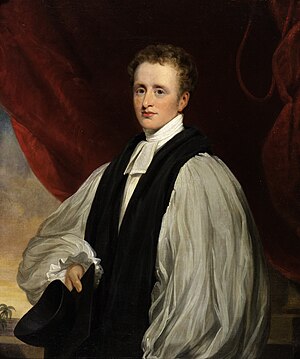Reginald Heber
|
The Rt Revd Reginald Heber D.D. M.A.(Oxon) B.D. |
|
|---|---|
| Bishop of Calcutta | |
 |
|
| Church | Church of England |
| Diocese | Anglican Diocese of Calcutta |
| Orders | |
| Ordination |
|
| Consecration | 1 June 1823 (bishop) |
| Personal details | |
| Born |
21 April 1783 Malpas, Cheshire, Great Britain |
| Died | 3 April 1826 (aged 42) Trichinopoly (Tiruchirappalli), Madras Presidency, British India |
| Nationality | British |
| Denomination | Anglican |
| Spouse | Amelia (m. 1809) |
| Children | 2 daughters |
Reginald Heber (21 April 1783 – 3 April 1826) was an English bishop, traveller, man of letters and hymn-writer who, after working as a country parson for 16 years, served as the Bishop of Calcutta until his sudden death at the age of 42.
The son of a wealthy landowner and cleric, Heber gained an early reputation at Oxford University as a poet. After graduation, he expanded his view of the world by undertaking, at the height of the Napoleonic Wars, an extended tour of Scandinavia, Russia and central Europe. He was ordained in 1807, and took over his father's old parish of Hodnet in Shropshire. He combined his pastoral duties with other church offices, hymn-writing, and more general literary work which included a critical study of the complete works of the 17th-century cleric Jeremy Taylor.
Heber was consecrated Bishop of Calcutta in October 1823. During his short episcopate he travelled widely in the areas of India within his diocese, and worked hard to improve the spiritual and general living conditions of his flock. A combination of arduous duties, hostile climate and indifferent health brought about his collapse and death while visiting Trichinopoly (now Tiruchirappalli), after less than three years in India. Monuments were erected in his memory in India and in St Paul's Cathedral, London. A collection of his hymns was published shortly after his death; one of these, "Holy, Holy, Holy", is a popular and widely known hymn for Trinity Sunday.
The surname "Heber" is probably derived from "Haybergh", a hill in the Craven district of Yorkshire in north-eastern England, where the Heber family originated. The family held the lordship of the manor of Marton, and was granted a coat of arms during the reign of Queen Elizabeth I. In 1752 one of the family, Richard Heber, received the manor and estate of Hodnet Hall in Shropshire as a bequest from a cousin of his wife. The bequest included patronage of the parish of Hodnet. On Richard Heber's death in 1766 his brother, named Reginald, who had taken Holy Orders and was co-rector of the parish of Malpas in Cheshire, inherited the Shropshire estate. He then became rector of Hodnet, in addition to his share of the Malpas living. This Reginald married twice; the first union, to Mary Baylie, produced a son, Richard Heber, who became a distinguished book collector and was Member of Parliament for Oxford University. The second marriage, after Mary Baylie's death, was to Mary Allanson; it produced two further sons, the elder of whom, born at Malpas on 21 April 1783, was named Reginald after his father.
...
Wikipedia
